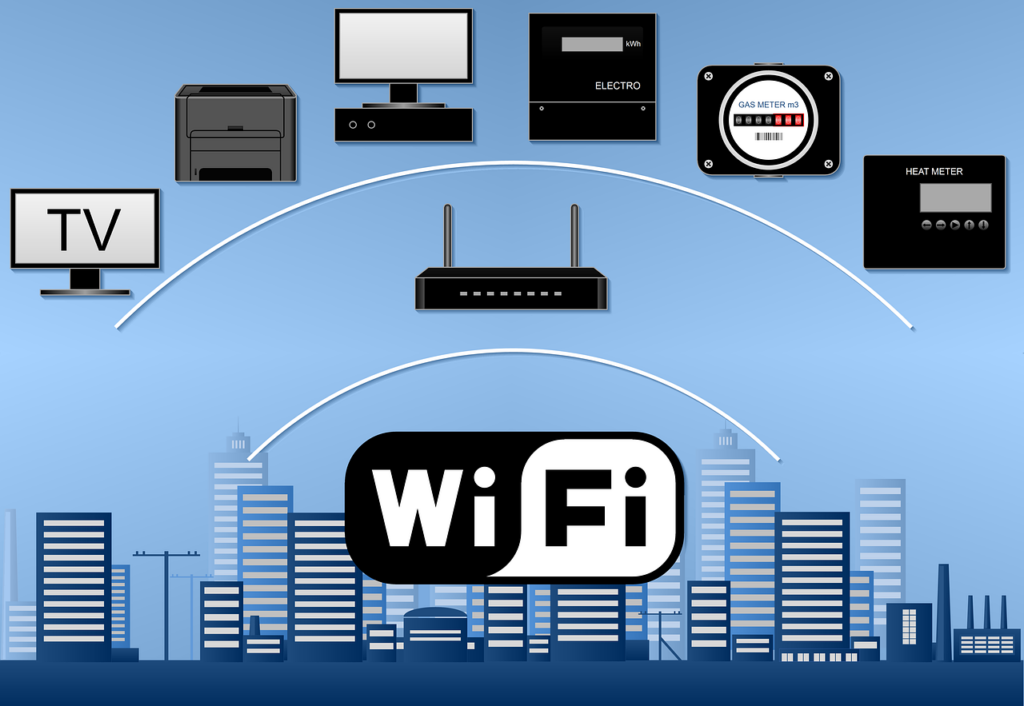Adverts
In the contemporary digital era, internet connectivity has become a necessity almost as basic as electricity or running water. Whether for work, study, entertainment or simply to stay connected with the world, the internet is an indispensable resource.
However, continuous internet access can represent a significant cost, especially when you are on the go. This is where apps to get free Wi-Fi come in, an innovative solution for staying online without affecting your wallet.
Adverts
These free Wi-Fi apps, available for various smartphone platforms, provide a way to find and connect to free Wi-Fi networks. They not only help you save on mobile data usage but are also a boon for travelers and people who are constantly on the move. However, with the variety of options available, there is a need to understand which applications are most efficient, secure and easy to use.
This article aims to explore the world of free Wi-Fi apps, highlighting the most popular and efficient ones available on the market. We'll cover how these apps work, the benefits, and security concerns when using public Wi-Fi networks.
Adverts
Additionally, we will take an in-depth look at each app's features, pros and cons, so you can choose the best option for your connectivity needs. Finally, we'll discuss some security best practices for when you're using these networks and take a look at future trends in this area. Connecting to the digital world for free is possible, and this article is your guide to navigating this new reality of connectivity.

Free Wi-Fi Apps Overview
The search for free Wi-Fi is a constant in the lives of many mobile users. With the advent of smartphones and the growing need to always be connected, applications that offer access to free Wi-Fi networks have gained popularity.
These apps work like a radar, identifying and providing details about available Wi-Fi hotspots around the user. But before we dive into the details of these apps, it's crucial to understand how they operate and what criteria we should consider when evaluating them.
How Free Wi-Fi Apps Work
These applications usually have a database of Wi-Fi networks, which includes both public access points and user-shared networks. When you activate the app, it uses your device's location to display a list of available Wi-Fi networks nearby. Some apps also offer additional functionality, such as offline maps, internet speed tests, and the ability to add new free Wi-Fi spots to your database.
Criteria for Evaluating Wi-Fi Apps
When choosing an app to find free Wi-Fi, consider the following criteria:
- Roof: An app's effectiveness depends heavily on its network of Wi-Fi hotspots. Apps with a broad global coverage are more useful, especially for travelers.
- Ease of Use: The user interface must be intuitive and easy to navigate. Complicated apps can discourage users from exploring their full functionality.
- Security: Since public Wi-Fi networks can be insecure, some apps offer security features or recommend the use of VPNs (Virtual Private Networks) to protect user data.
- User Reviews: Ratings and comments from other users can provide valuable insights into the app's reliability and effectiveness.
Common Application Features
Most free Wi-Fi apps share some common characteristics:
- Free Wi-Fi Maps: Allow users to view available Wi-Fi networks on a map, making it easier to find the nearest access points.
- User Feedback: Many apps allow users to rate and comment on the quality of Wi-Fi networks, providing valuable information to other users.
- Automatic Connectivity: Some apps give you the option to automatically connect to known, secure Wi-Fi networks.
- Offline Mode: Essential for travelers, this feature allows you to access Wi-Fi maps without needing an active internet connection.
By understanding the operation and features of these apps, as well as the criteria for evaluating them, users can make informed choices and maximize the benefits of having access to free Wi-Fi wherever they are. In the next section, we'll take an in-depth look at some of the most popular and effective apps in this category.
Detailed Analysis of Top Free Wi-Fi Apps

In this section, we'll dive into an in-depth look at some of the most popular apps for finding free Wi-Fi. Each application will be examined in terms of its features, ease of use, safety and effectiveness. Let's analyze three applications that stood out on the market for their reliability and functionality.
App 1: Wi-Fi Finder
Description: Wi-Fi Finder is widely recognized for its extensive database of Wi-Fi hotspots around the world. This app is particularly useful for travelers as it offers an offline map function.
Characteristics:
- Global database of Wi-Fi networks.
- Offline maps available for use without a data connection.
- Allows you to filter networks by type (free, paid) and location (cafe, hotel, etc.).
Pros:
- Wide coverage, especially useful when traveling internationally.
- Intuitive and easy-to-use interface.
- Offline maps feature is extremely useful.
Cons:
- The accuracy of Wi-Fi information depends on input from users.
- Some areas may have limited coverage.
App 2: Wi-Fi Map
Description: Wi-Fi Map is known for its community feature where users can add and share information about Wi-Fi networks.
Characteristics:
- Active community sharing Wi-Fi passwords and tips.
- Map functionality that shows Wi-Fi networks around the user.
- Option to download maps for offline use.
Pros:
- Large number of Wi-Fi networks available thanks to the active community.
- Social interface that allows interaction and sharing between users.
- Useful for finding Wi-Fi networks in urban areas.
Cons:
- Security can be a concern as many networks are shared by users.
- It may be less effective in rural or less populated areas.
App 3: Instabridge
Description: Instabridge is designed to offer a simplified user experience by making it easy to connect to free and secure Wi-Fi networks.
Characteristics:
- Emphasizes the quality and security of Wi-Fi networks.
- Simple and easy to use interface.
- It has a “Community Wi-Fi” feature, allowing users to share their private networks securely.
Pros:
- Focus on the security of Wi-Fi connections.
- User-friendly and uncomplicated interface.
- Good for users who prioritize secure and reliable connections.
Cons:
- Fewer networks available compared to other applications.
- It may not be ideal for users looking for as many Wi-Fi networks as possible.
Comparison between Applications:
- Roof: Wi-Fi Finder and Wi-Fi Map tend to have broader coverage, while Instabridge focuses on the quality of connections.
- Functionality: Wi-Fi Map offers a more social and community experience, while Instabridge focuses on simplicity and security.
- Usability: All three apps have user-friendly interfaces, but they differ in terms of additional features and focus.
Each of these apps has its own strengths and may be better suited to different types of users. In the next section, we'll discuss security tips when using public Wi-Fi networks, a crucial aspect when considering any of these applications.
Security Tips When Using Public Wi-Fi
When using public Wi-Fi networks, it is crucial to be aware of the security risks involved. Apps to find free Wi-Fi are convenient, but they can expose users to vulnerabilities. Below, we present essential tips for maintaining security when using these networks.
Avoid Transmitting Sensitive Information: When connected to a public Wi-Fi network, it is advisable to avoid activities that involve sharing sensitive information, such as banking, shopping online, or sending sensitive personal information. Open networks are more susceptible to data interceptions.
Use VPN (Virtual Private Network): A VPN creates a secure tunnel between your device and the internet, encrypting your data. This makes it much more difficult for third parties to access your information. Whenever possible, activate a VPN before connecting to public Wi-Fi.
Keep your Software Updated: Ensure your device's operating system and applications are always up to date. Updates often include security fixes for newly discovered vulnerabilities that can be exploited on insecure networks.
Turn off Auto-Sharing: On public networks, it's important to disable any settings that allow automatic file sharing or device connections. This minimizes the risk of unauthorized access to your device.
Check Wi-Fi Network Authenticity: Before connecting to a Wi-Fi network, verify that the network name and credentials are legitimate. Cybercriminals often create fake Wi-Fi networks with names similar to legitimate networks to trick unsuspecting users.
Use Secure Websites: When browsing the internet, give preference to sites that use HTTPS, indicated by a padlock in the browser's address bar. HTTPS encrypts the connection between your browser and the website, providing an additional layer of security.
Consider the Use of Antivirus and Firewalls: Good antivirus software and firewalls can provide additional protection against malware and other online threats. They act as a first line of defense to detect and block suspicious activity.
Be Aware of Your Surroundings: Finally, be aware of your physical surroundings when using public Wi-Fi networks. Avoid entering passwords or viewing confidential information in public places where people around you can spy on your screen.
By following these tips, you can minimize the risks associated with using public Wi-Fi networks and enjoy the benefits of free Wi-Fi apps with greater security. In the next section, we will explore future trends and innovations in the field of free Wi-Fi applications.
Future Trends and Innovations in Free Wi-Fi Apps
As we move into an increasingly connected future, free Wi-Fi apps are adapting and evolving to meet growing user demands. In this section, we'll explore some of the emerging trends and innovations that are shaping the future of these apps.
Rise of Artificial Intelligence and Machine Learning: The integration of Artificial Intelligence (AI) and Machine Learning into free Wi-Fi applications is becoming more prevalent. These technologies can enhance the user experience by personalizing the search for Wi-Fi networks, offering recommendations based on past usage patterns and individual preferences.
Security Improvements: With growing concerns about online security, free Wi-Fi apps are expected to invest more in security features. This could include implementing more robust security checks for public Wi-Fi networks and easier integration with VPN services.
Integrated and Automatic Connectivity: The future could bring deeper integration between free Wi-Fi apps and mobile devices, enabling automatic connections to trusted networks. This could include the ability to automatically switch between mobile data and Wi-Fi based on connection availability and quality.
Expanded Global Coverage: Expanding global coverage, especially in developing regions, is another key trend. This not only increases convenience for travelers, but is also crucial for offering internet access in areas where connectivity is still limited.
Partnerships with Local Businesses and Governments: Free Wi-Fi apps may begin to form more partnerships with local businesses and governments to expand access to Wi-Fi networks. This could include creating more public Wi-Fi hotspots in strategic locations such as parks, libraries, and transportation public.
Development of User Communities: Finally, building communities of active users around these apps could become more meaningful. This could involve encouraging users to share information about new Wi-Fi spots and provide feedback on the quality of connections.
These trends point to a future where access to free Wi-Fi will be more accessible, secure and personalized. As free Wi-Fi apps continue to develop, they will play an increasingly vital role in keeping people connected in an ever-evolving digital world. At the conclusion of our article, we will reflect on the impact and importance of these applications in modern society.

Summary of Key Points
As we conclude our exploration of apps for getting free Wi-Fi, it's clear that these digital resources represent more than mere conveniences; they are reflections of an increasingly interconnected and digitalized society. In these final lines, we will summarize the key points covered and reflect on the importance of these applications in the current scenario.
- The Growing Demand for Connectivity: The constant need for internet access, whether for professional, educational or personal reasons, has driven the popularity of free Wi-Fi applications.
- Variety of Options and Features: We explore different apps, each with their own unique features, from extensive Wi-Fi network databases to advanced security features.
- Security Concerns: We discuss how security is a pre-eminent concern when using public Wi-Fi networks and provide tips for browsing safely.
- Innovations and Future Trends: We look at how the technology behind these apps is evolving, including the use of AI and expanding global coverage.
Conclusion
These apps are more than just tools for finding an internet connection; they are portals to the vast world of information and communication. In many cases, they represent a social equalizer, providing internet access to those who may not have available or affordable mobile data connections. For travelers, they are a lifeline to stay connected in foreign lands.
Furthermore, as we move towards an even more connected future, these apps have the potential to play a crucial role in how we access and use the internet. The integration of advanced technologies and collaboration with local governments and companies could further expand access to the internet, making it an even more accessible and secure commodity for everyone.
In short, apps for finding free Wi-Fi are a window into the future of digital connectivity. They not only facilitate access to the internet, but also reflect the continuous changes in our relationship with technology and information. As these apps continue to evolve, they will certainly play a significant role in how we interact with the world around us, staying connected, informed and engaged.
